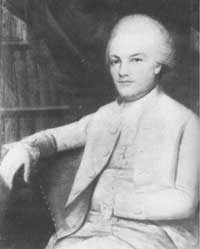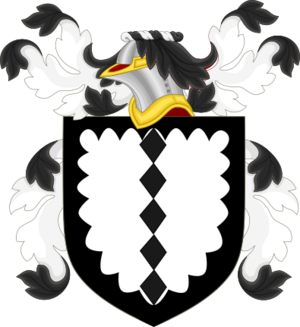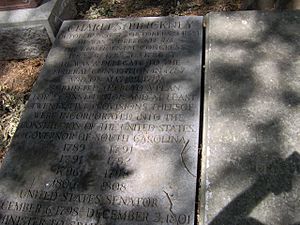Charles Pinckney (governor) facts for kids
Quick facts for kids
Charles Pinckney
|
|
|---|---|
 |
|
| 37th Governor of South Carolina | |
| In office December 1, 1806 – December 10, 1808 |
|
| Lieutenant | John Hopkins |
| Preceded by | Paul Hamilton |
| Succeeded by | John Drayton |
| In office December 1, 1796 – December 6, 1798 |
|
| Lieutenant | Robert Anderson |
| Preceded by | Arnoldus Vanderhorst |
| Succeeded by | Edward Rutledge |
| In office January 27, 1789 – December 5, 1792 |
|
| Lieutenant | Alexander Gillon Isaac Holmes |
| Preceded by | Thomas Pinckney |
| Succeeded by | William Moultrie |
| Member of the U.S. House of Representatives from South Carolina's 1st district |
|
| In office March 4, 1819 – March 3, 1821 |
|
| Preceded by | Henry Middleton |
| Succeeded by | Joel Roberts Poinsett |
| United States Minister to Spain | |
| In office June 6, 1801 – October 25, 1804 |
|
| President | Thomas Jefferson |
| Preceded by | David Humphreys |
| Succeeded by | James Bowdoin III |
| United States Senator from South Carolina |
|
| In office December 6, 1798 – June 6, 1801 |
|
| Preceded by | John Hunter |
| Succeeded by | Thomas Sumter |
| Delegate from South Carolina to the Congress of the Confederation | |
| In office November 1, 1784 – October 30, 1787 |
|
| 1st President of the South Carolina Senate | |
| In office August 31, 1779 – January 8, 1782 |
|
| Preceded by | Position established |
| Succeeded by | John Lloyd |
| Member of the South Carolina Senate from St. Phillip's and St. Michael's Parish | |
| In office August 31, 1779 – January 8, 1782 |
|
| Member of the South Carolina House of Representatives from St. Phillip's and St. Michael's Parish | |
| In office November 26, 1810 – November 28, 1814 |
|
| Member of the South Carolina House of Representatives from Christ Church Parish | |
| In office November 24, 1806 – December 9, 1806 |
|
| In office November 26, 1792 – December 8, 1796 |
|
| In office January 1, 1787 – January 21, 1789 |
|
| Personal details | |
| Born | October 26, 1757 Charles Town, South Carolina (now Charleston) |
| Died | October 29, 1824 (aged 67) Charleston, South Carolina |
| Resting place | Saint Philip's Episcopal Church Cemetery, Charleston 32°46′45″N 79°55′45″W / 32.7792°N 79.9291°W |
| Political party | Federalist |
| Other political affiliations |
Democratic-Republican |
| Spouse | Mary Eleanor Laurens |
| Relations | Colonel Charles Pinckney (father) Frances Brewton (mother) |
| Children | 3 |
| Residences | "Snee Farm", Mount Pleasant, South Carolina, Charleston, South Carolina |
| Profession | Lawyer, Statesman |
Charles Pinckney (born October 26, 1757 – died October 29, 1824) was an important American leader. He was one of the people who signed the United States Constitution. He also served as the Governor of South Carolina three times. Later, he became a U.S. Senator and a member of the House of Representatives. He was a distant cousin of another famous signer, Charles Cotesworth Pinckney.
Many future South Carolina governors were descendants of Charles Pinckney.
Contents
Early Life and Family
Charles Pinckney was born and grew up in Charleston, South Carolina. His father, Colonel Charles Pinckney, was a wealthy lawyer and plantation owner. His mother, Frances Brewton, came from a well-known family in Charleston.
During the American Revolutionary War, when the British took over Charleston in 1780, Charles's father signed an oath of loyalty to them. This helped him keep his property. When his father passed away in 1782, Charles inherited Snee Farm, a large plantation outside the city, and the many enslaved people who lived and worked there.
Charles Pinckney married Mary Eleanor Laurens on April 27, 1788. Mary was the daughter of Henry Laurens, a very wealthy and powerful politician and merchant in South Carolina. Charles and Mary had at least three children. His family connections included his father-in-law Henry Laurens and U.S. Representative David Ramsay.
Political Career and the Constitution
Charles Pinckney began his political career early. He was chosen as a delegate to the Third Continental Congress from 1777 to 1778. He started practicing law in Charleston in 1779 when he was 21.
During the American Revolutionary War, Pinckney joined the militia. He became a lieutenant and fought at the siege of Savannah in 1779. When Charleston was captured by the British the next year, Pinckney was taken prisoner. He was held until June 1781.
After the war, Pinckney was elected to the Continental Congress again, serving from 1784 to 1787. He also served many terms in the state legislature. He worked hard to make the United States stronger and to secure important rights, like navigation on the Mississippi River.
Pinckney owned several plantations and a townhouse in Charleston. His wealth came from these properties and the labor of enslaved people. Records from 1790 show he held over 100 enslaved people across his different properties.
Shaping the U.S. Constitution
Pinckney played an important role in the Constitutional Convention. This was a meeting where leaders created the U.S. Constitution. Although he was one of the youngest delegates, he spoke often and helped solve problems during the debates. He also worked to get the Constitution approved in South Carolina in 1788.
One important part Pinckney helped introduce was the Fugitive Slave Clause. This clause said that enslaved people who escaped to other states had to be returned to their owners. Some delegates disagreed with this, but it was eventually added to the Constitution. This clause was later strengthened by the Fugitive Slave Act of 1850. It remained in effect until the Thirteenth Amendment ended slavery in the United States.
Pinckney also helped add the "no religious test" clause to the Constitution. This important rule means that no one needs to have a specific religion to hold a public office in the United States. This was a new idea at the time.
He also pushed for the inclusion of Habeas Corpus in the Constitution. This legal right protects people from being held in prison without being told why or having a fair trial. It is now part of Article 1 of the United States Constitution.
Governor and Later Years
Pinckney's political career continued to grow. He was elected governor of South Carolina from 1789 to 1792. During this time, he led the state convention that wrote South Carolina's own constitution. He was initially a leader in the Federalist Party, but his views began to change.
By 1795, he started to disagree with some Federalist policies. He began to support the Democratic-Republican Party, which was popular in the western parts of South Carolina. In 1796, he was elected governor again. In 1798, his Democratic-Republican supporters elected him to the U.S. Senate.
Pinckney strongly opposed the actions of his former party. In the 1800 presidential election, he helped Thomas Jefferson win in South Carolina. Jefferson then appointed Pinckney as the U.S. Minister to Spain (1801–1805). While in Spain, he helped with the Louisiana Purchase in 1803, which greatly expanded the United States.
After returning from Spain, Pinckney became a leader of the Democratic-Republican Party in South Carolina. He served in the state legislature again and was elected governor for a third time (1806–1808). As governor, he supported giving more fair representation to different parts of the state. He also believed that all white men should have the right to vote.
He served in the legislature again from 1810 to 1814. In 1818, he was elected to the United States House of Representatives. There, he spoke out against the Missouri Compromise, which aimed to balance free and slave states. As a major slaveholder, he supported allowing slavery to expand into new territories.
In 1821, due to declining health, Charles Pinckney retired from politics for good. He passed away in 1824.
Legacy
- Charles Pinckney's Snee Farm plantation is now a national historic site called Charles Pinckney National Historic Site.
- His son, Henry L. Pinckney, became a U.S. Representative and mayor of Charleston. His daughter married Robert Young Hayne, who also became a U.S. Representative, mayor, and governor of South Carolina.
- Charles Pinckney was also a Freemason, a member of Solomon’s Lodge No. 1 in Charleston.



